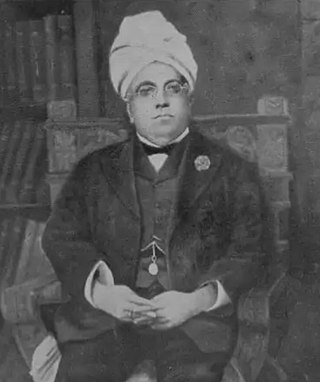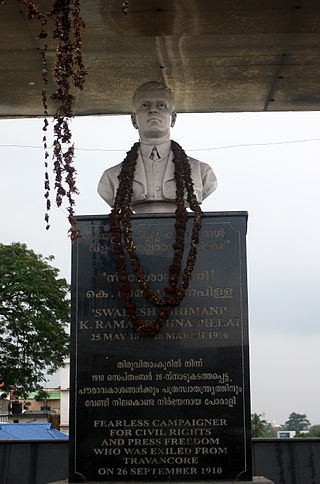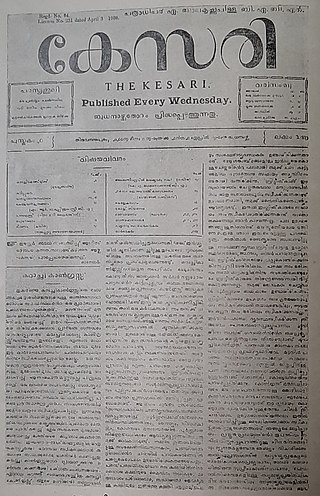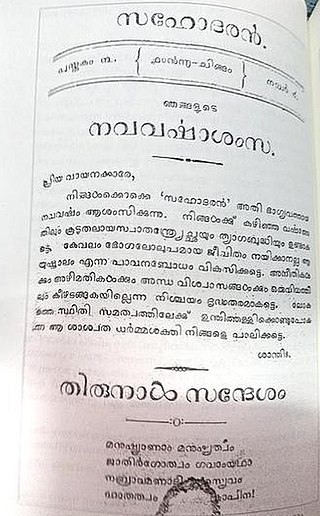Related Research Articles

Kozhikode, also known in English as Calicut, is a city along the Malabar Coast in the state of Kerala in India. It has a corporation limit population of 609,224 and a metropolitan population of more than 2 million, making it the second largest metropolitan area in Kerala and the 19th largest in India. Kozhikode is classified as a Tier 2 city by the Government of India.

Malayalam, the lingua franca of the Indian state of Kerala and the union territories of Lakshadweep and Puduchery, is one of the six classical languages of India. Malayalam literature comprises those literary texts written in Malayalam, a South-Dravidian language spoken in the Indian state of Kerala. The first travelogue in any Indian language is the Malayalam Varthamanappusthakam, written by Paremmakkal Thoma Kathanar in 1785. Malayalam literature has been presented with 6 Jnanapith awards, the second-most for any Dravidian language and the third-highest for any Indian language.

Thalassery, formerly Tellicherry, is a municipality and commercial city on the Malabar Coast in Kannur district, in the state of Kerala, India, bordered by the districts of Mahé (Pondicherry), Kozhikode, Wayanad, Kasaragod and Kodagu (Karnataka). Thalassery municipality has a population just under 100,000. Thalassery Heritage City has an area of 23.98 square kilometres (9.26 sq mi). Thalassery has an altitude ranging from 2.5 to 30 metres above mean sea-level.
Malayalam journalism encompasses journalism published and broadcast in the Malayalam language. Modern Malayalam journalism can be traced to the publication of the Raajyasamaachaaram and the Pashchimodhayam under the direction of Hermann Gundert in June 1847. Kerala has the highest media exposure in India with newspapers publishing in nine languages, mainly English and Malayalam.

Kozhikode, or Calicut district, is one of the 14 districts in the Indian state of Kerala, along its Southwestern Malabar Coast. The city of Kozhikode, also known as Calicut, is the district headquarters. The district is 67.15% urbanised.

Vengayil Kunhiraman Nayanar was a Malayali essayist and short story writer, and a prominent landlord of Malabar district.

Bhashaposhini is an Indian monthly magazine. It is one of the oldest Malayalam literary review magazines.

Moorkoth Kumaran (1874–1941) was a social reformer, a teacher and a writer in Malayalam. He came from a Thiyya family of Telicherry. He was a disciple of Narayana Guru and wrote the first biography of Guru. He also published some of the earliest short stories and novels in Malayalam.

K. Ramakrishna Pillai (1878–1916) was an Indian nationalist writer, journalist, editor, and political activist. He edited Swadeshabhimani, the newspaper which became a potent weapon against the rule of the British and the erstwhile princely state of Travancore and a tool for social transformation. His criticism of the Diwan of Travancore, P. Rajagopalachari and the Maharajah led to the eventual confiscation of the newspaper. Ramakrishna Pillai was arrested and exiled from Travancore in 1910. Vrithantha Pathra Pravarthanam (1912) and Karl Marx (1912) are among his most noted works in Malayalam, Vrithantha Pathra pravarthanam being the first book on journalism in Malayalam and Karl Marx, the first ever biography of Karl Marx in any Indian language. But it has been alleged that he plagiarized the biography from an essay, Karl Marx:A Modern Rishi, by Lala Hardayal, published in 1912 March issue of the Modern Review, published from Kolkata.
Sanulla Makti Thangal was the renaissance leader of Muslim society in Malabar of British India and the advocate of western education among the backward community of Mappila. He was notable as the first Muslim scholar and first Salafi leader to know the significance of the progressed western culture and the necessity of the western education to realize the reformation of knowledge. He commenced his career as the excise inspector under British government in India and later resigned from the post to defend the Christian missionaries. He dreamt about new Muslim society who will imbibe the advantages of western culture without getting rid of the valuable Islamic culture.
Kerala Pathrika was the first and earliest Malayalam language newspaper based in Calicut, India. Its first issue was published on 19 October 1884. Chengalathu Kunhirama Menon was the founder and chief editor of the paper.

Al Ameen was a Malayalam language newspaper founded in 1924 by Mohammed Abdur Rahiman in Calicut, India. It continued its publication until 1939 when it was banned by the Madras government for campaigning in support of India's non-cooperation in World War II. Al Ameen has a very important place in the history of Indian independence movement in Malabar.
V. Anil Kumar popularly known as Anil Vallathol is a Malayalam language writer and academic from Kerala, India. Anil hails from the family of the poet Vallathol Narayana Menon.
Chenkulath Cheriya Kunhirama Menon (1882–1939), also known by his nom de plume M. R. K. C., was a Malayalam–language author and journalist from Kerala, India. He was associated with prominent newspapers and periodicals such as Kerala Pathrika and Mangalodayam. Some of his famous books include Velluva Kammaran Allenkil Sardar Sheikh Ayaz Khan and M. R. K. C. yude Cherukathakal. M. R. K. C. along with Moorkoth Kumaran, Vengayil Kunhiraman Nayanar, Oduvil Kunhikrishna Menon, C. S. Gopala Panicker and Ambadi Narayana Poduval are regarded as the pioneers of the short story in Malayalam literature.
Prabhatham was a Malayalam-language weekly newspaper published from Shoranur in Malabar, British India. Founded in 1935 and edited by E. M. S. Namboodiripad, it was the organ of the Congress Socialist Party (CSP) in Malabar, Travancore and Cochin. The newspaper was subjected to censorship right from its inception. It had to close down due to the heavy security imposed on the paper for publishing a poem on Bhagat Singh's death. The newspaper resumed publication in April 1938. It shifted to Calicut and continued as a weekly until the outbreak of World War II in September 1939. Prabhatham was a short-lived newspaper both because of the colonial repression and because the CSP had lost its relevance after the formation of the Communist Party of India. The newspaper was instrumental in spreading socialist and communist ideologies in Kerala.

Malayala Rajyam was a Malayalam-language newspaper founded by K. G. Shankar in 1929 in Quilon, Travancore. Its main aim was to support the Indian independence movement and the activities of Indian National Congress. It became a daily in 1931 and was amongst the earliest daily morning newspapers in Kerala. The newspaper featured despatches from the Associated Press of India and Reuters as well as news pictures fed by international photo agencies. It had modern printing equipment and even operated a bus service to distribute the copies to agents on time. The news agency Keralapress was established in 1930 in Madras and served as a mail service giving news about Malayali activities in Madras to Malayala Rajyam.
Mithavadi was a Malayalam-language newspaper published from Tellicherry and later from Calicut in Malabar, British India. It was established by T. Sivasankaran in 1907. Moorkoth Kumaran was the editor. He merged his Kerala Sanchari newspaper with Mithavadi. In 1913, C. Krishnan purchased the newspaper and published it from his Empire Press, Calicut. Mithavadi was particularly popular among the Thiyya community and was instrumental in pioneering tenant agitations in Malabar.

Kesari was an Indian weekly newspaper in Malayalam, published from Trivandrum under the editorship and ownership of A. Balakrishna Pillai, who later came to be known by the name Kesari Balakrishna Pillai. Pillai started the newspaper in 1930, a week after the license of his independent weekly Prabodhakan was revoked by the government per the Travancore Newspaper Regulations Act of 1926. Pillai was imposed a fine of Rs. 200 for contempt of court. Pillai obtained a new newspaper licence from Narayana Pillai who was running a weekly named Kesari at the time. Kesari effectively replaced Prabhodhakan and Pillai continued his fight against the government and corruption in the system through Kesari. It was printed at Sharada Press which Pillai had established in 1926. Pillai continued the publication of Kesari till 1935 when the Newspaper Act was modified and the transfer of press licenses was prohibited. According to the new law, the license fee was increased to Rs. 1,000. Pillai travelled to places like Malaysia and Singapore to collect funds but collecting money was seen as unethical so he did not go ahead with it. The newspaper was discontinued due to mounting debts in April 1935; Pillai had to sell Sharada Press to pay off the debts. Balakrishna Pillai's editorials for Kesari were popular. He strongly criticised the government through his editorials and also dealt with literary subjects. His articles in Kesari have been compiled and published as a book.

Sahodaran was an Indian Malayalam-language newspaper published in Kerala from 1917 to 1956. It was the mouthpiece of Sahodara Sangham, an organisation founded by Sahodaran Ayyappan to fight against the caste system in Kerala.
References
- ↑ Stella Joseph. "Tenancy - A much debated issue" (PDF). Print and public sphere in Malabar: a study of early newspapers (1847-1930) (Thesis). University of Calicut. hdl:10603/13232.
- 1 2 3 Perunna K. N. Nair (1976). Malayala Patrathinte Katha [History of Malayalam Journalism (1847–1947)] (PDF) (in Malayalam). Cochin: Published by the author. pp. 37–38.
- ↑ "History of Media in Kerala". Kerala Media Academy. Retrieved 15 February 2023.
- ↑ J. Natarajan (1955). History of Indian Journalism. Publications Division Ministry of Information & Broadcasting. ISBN 978-8-123-02638-1.
- ↑ "History of Press in Kerala". Public Relations Department, Government of Kerala. Archived from the original on 7 August 2014. Retrieved 12 February 2023.